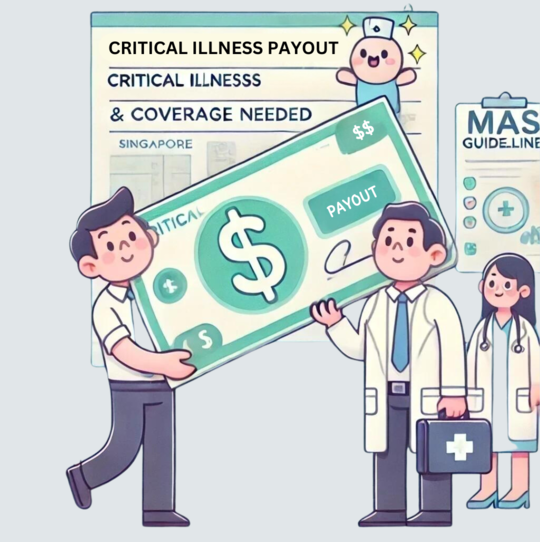How much critical illness coverage do you need?
Recommended coverage in Singapore based on MAS guidelines and what makes sense

If you are reading this article, you probably know the importance of having some critical illness coverage. If not, here’s a quick reason why having critical illness coverage is important. Critical illness coverage gives you the lump sum payout almost like “pay advancement”, so you can stop working for a number of years and focus on recovering. But the million dollar question is, how much is enough?

What do the big boys think?
In October, the Monetary Authority of Singapore (MAS), in collaboration with the Association of Banks in Singapore (ABS), Association of Financial Advisers (Singapore) (AFAS), and Life Insurance Association (LIA), introduced a recommendation advocating for critical illness coverage equivalent to four years of your income.
This guideline aims to provide a financial safety net, allowing individuals diagnosed with a critical illness to receive an insurance payout equivalent to four years of income. This ensures they can afford to take necessary time off work for up to four years, focusing on recovery without the burden of financial stress.
Why do we need 4 times of our annual income for critical illness?
After some digging, it is clear that the guideline of four times your annual income is not a random number. While it may seem arbitrary, it is grounded in the practical need to cover a broad spectrum of potential costs and ensure financial stability during recovery.
How much do we actually need?
To determine how much we really need, we are going to make use of a few parameters:
- Duration of recovery: This helps estimate how long a break you might need if diagnosed with a critical illness.
- Other potential hidden costs: The most obvious cost of critical illness is hospital and treatment bills. In most cases, the majority of these bills are covered under your hospitalisation plan, which is why it is arguably the most important medical insurance you need. However, beyond the bills, critical illness can entail additional costs such as future income loss, hiring a caregiver, and home modifications.
Context setting
The amount of coverage required varies depending on factors such as the severity, type of illness, and stage of detection. To get a rough understanding, let’s look at the most common critical illnesses in Singapore. These include cancer, stroke, heart-related issues and kidney related diseases

Typical treatments and recovery periods
Disclaimer: This isn’t written by someone medically trained; we’re just putting the pieces of information we found on the internet together.
| Illness | Typical Treatments | Average Treatment/Recovery Period |
|---|---|---|
| Prostate Cancer | Surgery (radical prostatectomy), regular hormonal therapy (source) | 80% of those that detection before stage 3 will likely be cancer-free after 5 years (source-1)(source-2) |
| Breast Cancer | Surgery (Lumpectomy/ Mastectomy), radiotherapy, hormonal therapy (source) | 3 to 12 months or up to 10 years if hormonal therapy is needed (source) |
| Colon & Rectum Cancer | Surgery (Local excision/ colectomy), Radiation therapy, Immunotherapy (source) | Average treatment period: from 2 months up to 6 months (source) |
| Heart Attack | Surgery (Coronary Angioplasty), Thrombolysis | 2 weeks to 3 months, but likely have some irreversible damage. (source) |
| Stroke | N/A | Varies significantly; recovery can take weeks, months, or even years (source) |
| Kidney Diseases | Blood pressure management, Surgery (Transplant), Dialysis | Several months for early-stage; lifelong for severe cases requiring dialysis (source) |
Other potential hidden costs
| Cost | Details |
|---|---|
| Caregiver Impact |
Read more here |
| Professional caregiver | $600+ to $1,000+ per month for a live-in caregiver (source) |
| Job Loss and Change |
Read more here |

So What?
If you’ve made it this far into the article, you’re likely convinced about the necessity of critical illness coverage or are seriously considering it. The guidance from MAS and fellow associations to aim for a coverage of four times your annual income serves as a beacon, guiding us towards financial readiness in the face of health adversities. Yet, the journey of determining the ‘right amount’ of coverage isn’t a one-size-fits-all scenario.
As we’ve explored, the actual needs extend beyond a lump sum payout; they delve into the realm of recovery durations, unforeseen expenses, and the indirect costs that come with life-altering diagnoses. The common critical illnesses in Singapore serve as a reminder that preparation is not just about facing the immediate medical bills but also about ensuring resilience in the long-term aftermath.
What’s the verdict?
The statistics above are based on available online data, but we personally know people who have battled illnesses for much longer. Realistically, when considering the financial implications of critical illnesses, many factors come into play: medical aspects like treatment and recovery time, severity, and effectiveness of treatment, as well as patient demographics.
Due to this variation, determining the financial risk to hedge against is challenging. However, we believe aiming for four times your annual income is a reliable approach, especially for covering potential job loss.
Of course all of what we’ve mentioned comes with the caveat that you have your hospital insurance covered.
Conclusion
Unfortunately or fortunately, we don’t know what illness we will get. While four times your annual income is a solid starting point, the crux of effective critical illness coverage lies in a personal audit of potential recovery times, additional costs, and the unique financial implications of being out of work. Which is really hard to tell.